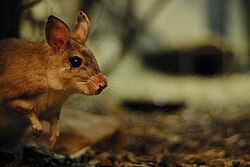| Malagasy rodents Temporal range: Middle Miocene - Recent | |
|---|---|
 | |
| The Malagasy giant rat Hypogeomys antimena has a body length of 30–35 cm (12–14 in). | |
| Scientific classification | |
| Kingdom: | Animalia |
| Phylum: | Chordata |
| Class: | Mammalia |
| Order: | Rodentia |
| Family: | Nesomyidae |
| Subfamily: | Nesomyinae Forsyth Major, 1897 |
| Genera | |
Brachytarsomys | |
The Malagasy rodents are the sole members of the subfamily Nesomyinae. [1] These animals are the only native rodents of Madagascar, come in many shapes and sizes, and occupy a wide variety of ecological niches. There are nesomyines that resemble gerbils, rats, mice, voles, and even rabbits. There are arboreal, terrestrial, and semi-fossorial varieties.
These rodents are clearly most closely related to some muroid rodents found on the African mainland. Some molecular phylogeneticists consider this clade of Malagasy and African rodents to represent a distinct family, the Nesomyidae. Other researchers place the Nesomyinae into a large family, Muridae, along with all members of the superfamily Muroidea.
It has been reported that the Nesomyinae is not monophyletic, [2] but this has not been supported in other analyses. Additionally, there were problems with this particular study, notably the use of Calomyscus as an outgroup while more distantly related muroids (rhyzomyines) were included in the ingroup. It seems likely that all rodents in Madagascar are descendants from a single invasion of the island.
If monophyletic, the nesomyines represent one of only four colonization events of terrestrial mammals from mainland Africa. The other groups are tenrecs, lemurs and Malagasy carnivorans. Molecular clock analyses suggest that the ancestor of the nesomyines colonized Madagascar about 20–25 million years ago. [3] This is at approximately the same time as the Malagasy carnivorans, but is considerably more recent than the estimated colonization times of tenrecs and lemurs.